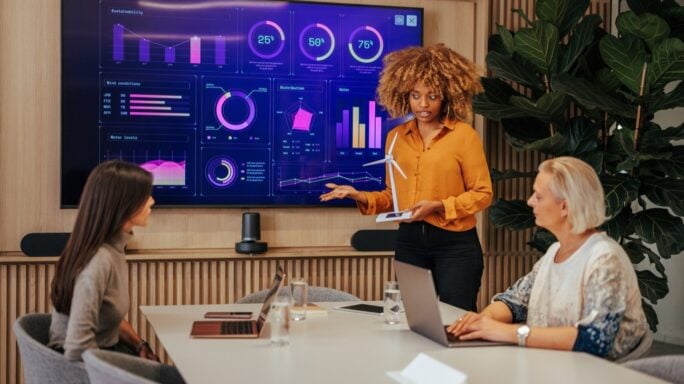Virtual reality and augmented reality: Why HR and People leaders should embrace VR and AR
Tom Haak, director of the HR Trend Institute, explains why HR and People leaders should embrace virtual reality and augmented reality applications.

Tom Haak, director of the HR Trend Institute, explains why HR and People leaders should embrace virtual reality and augmented reality applications.
Virtual reality (VR) and augmented reality (AR) technologies are not passing fads.
Once just the sci-fi creation of film makers, now the technology exists, and it’s already being used to great effect by many early adopters.
Although the HR sector may be slower to adopt the technology, the possible application areas of VR and AR in the HR domain are phenomenal.
Here are just a few ideas to get you started.
Transform your workforce with Sage
No matter the size of your team, Sage offers HR solutions to help you lead, manage, and engage your people.

Candidate sourcing and pre-selection – try before you buy
How many times have you wondered if a candidate will be an excellent worker or if they are just good at interviews?
VR technology enables HR and People teams to simulate a near real experience.
If you want to see how your candidate will handle a tricky customer on a shop floor or deal with a crisis, VR can create that scenario for you.
This gives you a chance to really see how your candidate reacts and gives them a chance to see if this is the kind of job they really want to do, too.
Selection – the world is your recruitment pool
Cast your net wider by interviewing candidates from all over the world. You are no longer constrained to the pool of people in your town, city or even your country.
A candidate can be interviewed without having to travel to the location of the organization, and still get a very real interview experience.
Onboarding – make sure they are ready for work
VR enables HR and People teams to help new candidates be a part of the business before they join, wherever they are in the world.
They can learn about the business, products and services. They can even virtually visit all of your office locations so that when they walk through the door on their first day of work, it feels like they’re already part of the family.
Training – the possibilities are endless
The possibilities of VR and AR for learning and training are endless.
When training employees on how to use complex and expensive machinery, it’s far easier and just as effective to train them on virtual machines.
Also, training medical students on complex procedures becomes possible using VR, where it would be impractical or dangerous to use a real human.
I once had to deal with a virtual oil leak for an oil and gas client. The situation felt very real and frightening, even though it was just a simulation for health and safety training.
Take an interactive tour of Sage People
Discover how Sage People can transform the way you hire, manage, engage, and retain your workforce in this self-guided interactive product tour.

Enhancing real work – combine human and machine force
Human force has its limitations. Machines can greatly enhance a human’s capabilities so that things which are not humanly possible, become possible.
Together with AR, people can achieve amazing things and save lives in the process.
AR devices are helping surgeons in operating rooms to see every single miniscule detail inside their patients’ bodies before using the knife.
They are also used for maintenance in complex manufacturing environments. Heavy machinery can be scanned and accessed without having to take it apart which can be extremely dangerous.
Road works become a lot easier if you can see any cables under the surface, so that you avoid drilling into them.
But are HR and People teams adopting VR and AR?
In my view, it’s early days. Generally, the uptake of HR tech is slow. Also, it’s not so easy to quickly develop cool VR solutions.
Most solutions need to be tailored to be really effective, and that costs time and money.
Usually, organizations adopt technology when they have a crisis or an urgent issue to resolve. In many organizations, recruitment is an urgent issue, but developing VR solutions for employer branding and selection is probably not number one on the priority list.
Although we don’t have solid data, we predict that healthcare, along with industries that are connected to high risks (oil and gas and the military) and complex design and manufacturing environments are the likely sectors that will adopt VR and AR technology fastest.
What are the barriers to adoption?
New technology can be frightening. Many HR executives have not grown up using YouTube and Snapchat. Using VR and AR requires some imagination, and real experience helps.
Adopting new technologies also requires an experimental approach. Initially, the solutions will be far from perfect, but early adopters will learn fast, and they will be able to work closely with suppliers to improve the solution.
To really succeed in your adoption of AR and VR, you need to connect it to a business need.
Use them to solve a problem and once you have the solution, integrate that into your work and daily routines. VR and AR are not ‘nice to have’ gadgets, they are important business tools.
Embrace VR and reap the rewards
VR and AR are both immersive technologies with huge potential to transform and overhaul the way businesses operate.
Some of the key benefits to an organization of adopting VR and AR applications within HR include:
- Improving the candidate and employee experience
- Scalability: VR and AR solutions are a lot easier to scale up than human solutions
- Improved quality
- Cost efficiency
- Image improvement associated with innovations
I see the biggest uptake in using VR and AR technology being able to improve the quality and efficiency of real work.
On-the-job VR and AR tools will bring the biggest benefits. But this requires a real, and flawless integration.
Ultimately, VR and AR solutions have a key role to play in improving the candidate and employee experience.
With the potential to significantly improve employees’ productivity, enhance employee training and make workplaces safer, it’s definitely worth embracing this technology, not fearing it.
It might even offer a solution to one of the most pressing HR challenges of these times: closing the skills gap.
Deliver engagement through experiences
Download our eBook "Delivering engagement through experiences" to find out why it's time to change focus and where HR leaders can turn to drive productivity in their workplace.

Sage’s top five tips for using VR technology in the workplace
1. Improving the recruitment process
Using video technology has become increasingly common in early stage interviews, however it’s difficult to fully assess a candidate’s personality and body language in 2D.
Utilizing VR technology can facilitate the feeling of being in the same room together which will allow instinctive decisions to be made early on.
The ability to demonstrate skills would be thoroughly enhanced through use of VR as it presents the opportunity to take on tasks in real time, in authentic settings.
This would allow for industries who require specific skill sets to be established to easily carry out assessments.
2. Onboarding new employees
The induction process for new employees can be overwhelming with high volumes of information to process. VR can be introduced to onboard employees in engaging ways to help support retention of information, as well as providing a more entertaining approach to induction tasks.
This approach can help new employees become acclimatized quickly by immersing them into the culture of the company, departments and people to settle faster and in a productive manner.
3. Creating personalized workspace environments
By utilizing VR, employees can easily enter into a personalized virtual space that has been created and is designed to their specifications to create the perfect working environment for them.
Whether it be noise level, temperature, or lighting levels the ideal environment can be available for each person to work productively.
4. Training and education for staff
VR can massively enhance training for staff, from initial induction briefings through to specific role development skill training.
There are several benefits to utilizing VR technology in this way, such as, being able to create real-life scenarios for employees to learn through simulation. In turn, this makes training more engaging, which will help towards retention and recall of information.
VR is also adaptable.
It can make training courses more personalized to fit the skills being developed in the learning style of the employee for a tailored approach.
5. Improving connectivity across global companies
For global companies, a feeling of disconnect between employees is often an issue they face on a regular basis, as staff can struggle to gain the sense of a functional team without being able to physically see each other.
VR can break down the boundaries created by the physical distance between employees by allowing meetings to be carried out in 3D to gain the feeling of being in the same place. In addition, can be utilized for remote workers to be more involved in meetings happening in the office.






Ask the author a question or share your advice